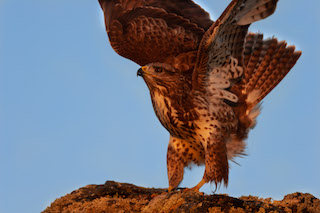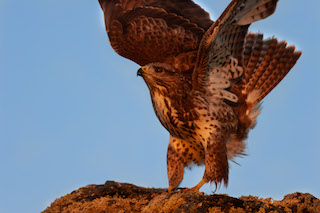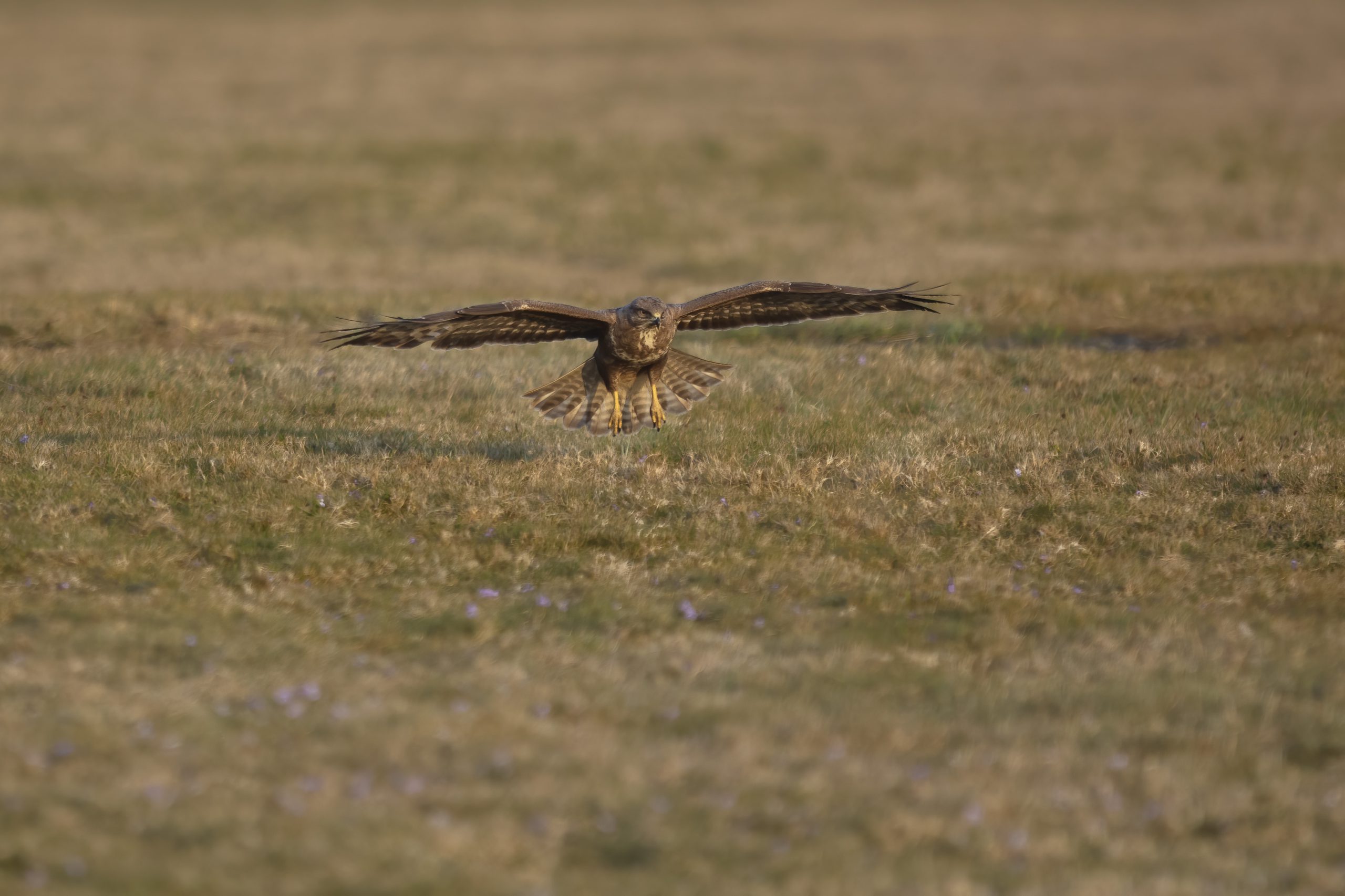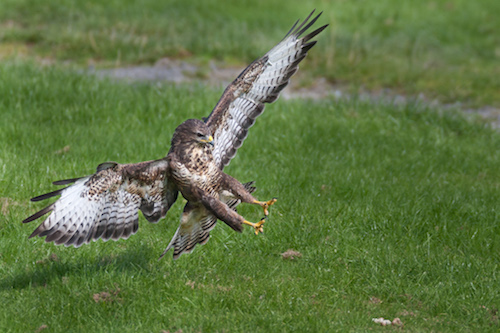 The Buzzard is the most common bird of prey in the UK.
The Buzzard is the most common bird of prey in the UK.
Photo: Richard Birchett
Scientific name: Buteo buteo
Other common names: Common Buzzard, Eurasian Buzzard
Cornish name: Bargos
Conservation status: IUCN Red List, Least Concern; UK Birds of Conservation Concern, Green
What to look for:
- Family: Accipitridae
- Colouring and appearance: Colour is variable, from dark to pale brown, but can also sometimes be reddish or black, with dark tips to its broad wings and narrow bars on the tail and flight feathers. The underparts are paler than the upperparts, and the head and tail are rounded in shape.
- Size: 54 cm length, 120 cm wingspan.
- Where: Can be seen hunting across the UK in most open habitats, including urban areas; breeds in woodlands. Its global range covers Europe, Africa and Asia. It is resident in the UK, but migratory in northern parts of its global range.
- Call: A mewing cry
- Similar species: Honey Buzzard, which is a summer visitor.
 The Buzzard is not only the most common bird of prey in the United Kingdom, numbering up to almost 70,000 pairs in the breeding season, but also the most widely distributed: it can be found in every county. Sometimes mistaken for an eagle, it is smaller but is nonetheless a fairly large bird of prey. On clear days, you can often spot a Buzzard wheeling and soaring high above, its mewing call haunting the air and its wings held outwards. You might also catch sight of one atop a post or tree, surveying the landscape. As spring arrives, watch out for the male’s roller-coaster display flight as he soars high in the sky and then tumbles fast downwards in acrobatic spirals and loops. This behaviour is either to attract a mate, or to remind his existing mate of his ‘credentials’: Buzzards pair for life.
The Buzzard is not only the most common bird of prey in the United Kingdom, numbering up to almost 70,000 pairs in the breeding season, but also the most widely distributed: it can be found in every county. Sometimes mistaken for an eagle, it is smaller but is nonetheless a fairly large bird of prey. On clear days, you can often spot a Buzzard wheeling and soaring high above, its mewing call haunting the air and its wings held outwards. You might also catch sight of one atop a post or tree, surveying the landscape. As spring arrives, watch out for the male’s roller-coaster display flight as he soars high in the sky and then tumbles fast downwards in acrobatic spirals and loops. This behaviour is either to attract a mate, or to remind his existing mate of his ‘credentials’: Buzzards pair for life.
 Buzzard pairs usually breed at the edges of woodland, building their nest – a large stick platform, lined with vegetation – in the fork of a tree or on a branch. Each clutch comprises two to four white eggs with red-brown speckling. The male provides food for the hatchlings while the female remains with the nest, and both parents feed the young for up to two months after they have fledged. Buzzards are fiercely territorial, defending their nest vigorously. Even so, in areas of plentiful prey it is not uncommon to spot more than one Buzzard in the sky, circling as they hunt. Prey items mainly comprise small mammals such as mice and voles, but
Buzzard pairs usually breed at the edges of woodland, building their nest – a large stick platform, lined with vegetation – in the fork of a tree or on a branch. Each clutch comprises two to four white eggs with red-brown speckling. The male provides food for the hatchlings while the female remains with the nest, and both parents feed the young for up to two months after they have fledged. Buzzards are fiercely territorial, defending their nest vigorously. Even so, in areas of plentiful prey it is not uncommon to spot more than one Buzzard in the sky, circling as they hunt. Prey items mainly comprise small mammals such as mice and voles, but
Buzzards will also catch small birds, large insects and reptiles, and feed on carrion.
Have Buzzards always been so numerous? In fact, at the end of the nineteenth century Buzzard numbers had plummeted due to persecution by landowners who considered them a threat to gamebirds. They also suffered in the middle decades of the twentieth century, victims of the ‘Silent Spring’ caused by organochlorine pesticides. After these were withdrawn in the late 1960s, and with the reduction in illegal killing as the very limited nature of the threat to gamebirds was better appreciated, numbers have increased, and the Buzzard is now our most common raptor.
Did you know…?
…Buzzards are long-lived: the oldest, recorded in 2014, was 28 years old.
…Each Buzzard pair might hold as many as twenty possible nest sites within their territory, moving to a new one each year.

More information and references:
Svensson, L., Mullarney, K., Zetterstrom, D.,1986. Collins Bird Guide, second edition (translated by Christie, D., Svensson, L.). HarperCollins, London.
Published: October 2014 (updated January 2020)
Author: Amanda Scott
Photos: all © Richard Birchett: top image, Buzzard in early morning light at Predannack; middle, Buzzard in flight; and bottom, Buzzard chasing insect prey at Kynance
